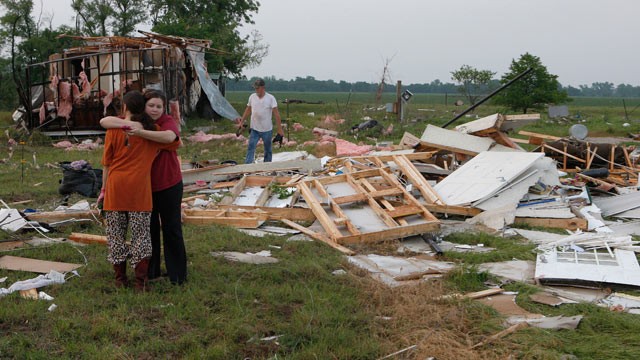The twister killed at least 51 people, and officials fear the death toll will rise.
Medical examiner spokeswoman Amy Elliott confirmed the children's deaths Monday night.
The tornado made a direct hit on an elementary school in Moore, Okla., and authorities were seen pulling children alive from the rubble.
Oklahoma City police say the search and rescue operation at the school is now a recovery effort. Authorities are still searching for victims -- and survivors -- throughout the community.
The monstrous tornado was at least a half-mile wide. It flattened entire neighborhoods and destroyed the elementary school as children and teachers huddled against winds of up to 200 mph.
The storm laid waste to scores of buildings in Moore, a community of 41,000 people about 10 miles south of the city. Block after block lay in ruins. Homes were crushed into piles of broken wood. Cars and trucks were left crumpled on the roadside.
The National Weather Service issued an initial finding that the tornado was an EF-4 on the enhanced Fujita scale, the second most-powerful type of twister.
176 people were being treated at hospitals, including dozens of children. Search-and-rescue efforts were to continue throughout the night.
Tiffany Thronesberry said she heard from her mother, Barbara Jarrell, shortly after the tornado.
"I got a phone call from her screaming, 'Help! Help! I can't breathe. My house is on top of me!"' Thronesberry said.

Oklahoma tornado as seen by storm chasers
Rescuers launched a desperate rescue effort at the school, pulling children from heaps of debris and carrying them to a triage center.
Oklahoma Gov. Mary Fallin deployed 80 National Guard members to assist with rescue operations and activated extra highway patrol officers.
Fallin also spoke with President Obama, who declared a major disaster and ordered federal aid to supplement state and local recovery efforts.
Many land lines to stricken areas were down, and cell phone networks were congested. The storm was so massive that it will take time to establish communications between rescuers and state officials, the governor said.
In videos of the storm, the dark funnel cloud could be seen marching slowly across the green landscape. As it churned through the community, the twister scattered shards of wood, awnings and glass all over the streets.
The tornado also destroyed the community hospital and some retail stores. Moore Mayor Glenn Lewis watched it pass through from his jewelry shop.
"All of my employees were in the vault," Lewis said.
Chris Calvert saw the menacing cloud approaching from about a mile away.
"I was close enough to hear it," he said. "It was just a low roar, and you could see the debris, like pieces of shingles and insulation and stuff like that, rotating around it."
Even though his subdivision is a mile from the tornado's path, it was still covered with debris. He found a picture of a small girl on Santa Claus' lap in his yard.
Volunteers and first responders raced to search the debris for survivors.
At Plaza Towers Elementary School, the storm tore off the roof, knocked down walls and turned the playground into a mass of twisted plastic and metal.
Children from the school were among the dead, but several students were pulled alive from the rubble. Rescue workers passed the survivors down a human chain to the triage center in the parking lot.
James Rushing, who lives across the street from the school, heard reports of the approaching twister and ran to the school, where his 5-year-old foster son, Aiden, attends classes. Rushing believed he would be safer there.
"About two minutes after I got there, the school started coming apart," he said.

Vine video shows devastation from OK tornado
A man with a megaphone stood Monday evening near St. Andrews United Methodist Church and called out the names of surviving children. Parents waited nearby, hoping to hear their sons' and daughters' names.
Don Denton hadn't heard from his two sons since the tornado hit the town, but the man who has endured six back surgeries and walks with a severe limp said he walked about two miles as he searched for them.
As reports of the storm came in, Denton's 16-year-old texted him, telling him to call.
"I was trying to call him, and I couldn't get through," Denton said.
Eventually, Denton said, his sons spotted him in the crowd. They were fine, but upset to hear that their grandparents' home was destroyed.

Okla. tornado survivor finds dog buried alive under rubble
Because the ground was muddy, bulldozers and front-end loaders were getting stuck. Crews used jackhammers and sledgehammers to tear away concrete, and chunks were being thrown to the side as the workers dug.
Douglas Sherman drove two blocks from his home to help.
"Just having those kids trapped in that school, that really turns the table on a lot of things," he said.
A map provided by the National Weather Service showed that the storm began west of Newcastle and crossed the Canadian River into Oklahoma City's rural far southwestern side about 3 p.m. local time When it reached Moore, the twister cut a path through the center of town before lifting back into the sky at Lake Stanley Draper.
Oklahoma City Police Capt. Dexter Nelson said downed power lines and open gas lines posed a risk in the aftermath of the system.
Monday's powerful tornado loosely followed the path of a killer twister that slammed the region in May 1999.
The weather service estimated that Monday's tornado was at least a half-mile wide. The 1999 storm had winds clocked at 300 mph.
Kelsey Angle, a weather service meteorologist in Kansas City, Mo., said it's unusual for two such powerful tornadoes to track roughly the same path.
It was the fourth tornado to hit Moore since 1998. A twister also struck in 2003.
Lewis, who was also mayor during the 1999 storm, said the city was already at work on the recovery.
"We've already started printing the street signs. It took 61 days to clean up after the 1999 tornado. We had a lot of help then. We've got a lot of help now."
Monday's devastation in Oklahoma came almost exactly two years after an enormous twister ripped through the city of Joplin, Mo., killing 158 people and injuring hundreds more.
That May 22, 2011, tornado was the deadliest in the United States since modern tornado record keeping began in 1950, according to the National Oceanic and Atmospheric Administration. Before Joplin, the deadliest modern tornado was June 1953 in Flint, Mich., when 116 people died,
SOURCE : http://www.cbsnews.com/8301-201_162-57585423/20-kids-among-at-least-51-dead-from-massive-okla-tornado/


















